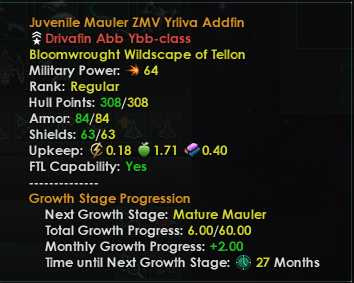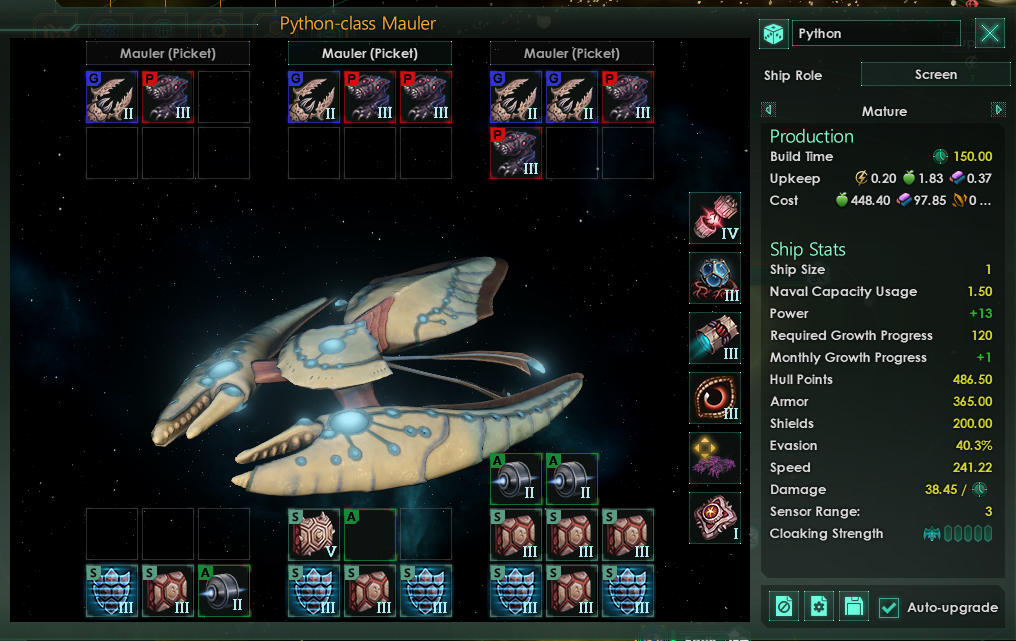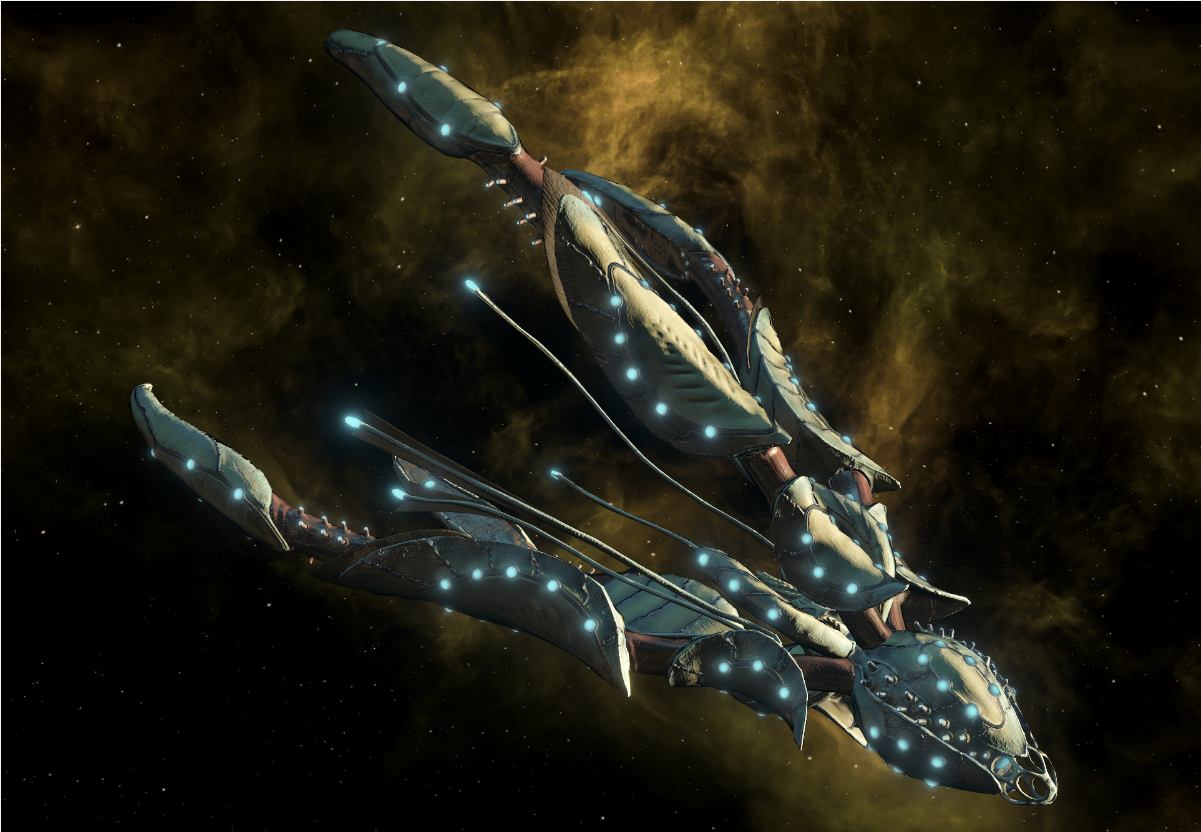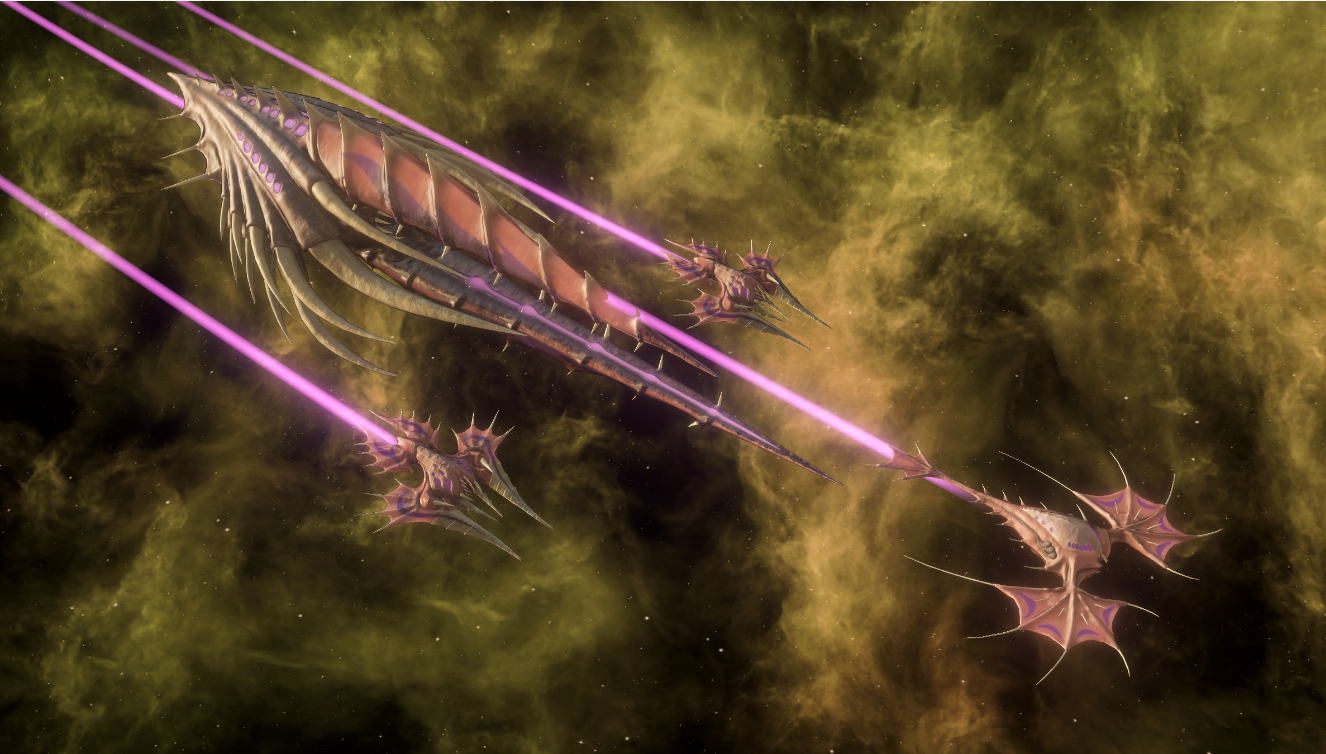Hello everybody! Welcome to our first BioGenesis development diary!
Today we will talk to about ships. That are made of meat!
—
Several weeks ago, Eladrin mentioned that the ship designer changes originally planned for 4.0 "Phoenix" would not be included in the Open Beta, as they’re now needed for our upcoming Q2 DLC release. We’ve since seen a fair amount of speculation as to what we might have been cooking that’d require such changes… So please allow me to introduce our Biological Ships!
In BioGenesis, we are adding two distinct Biological shipsets, with unique ship classes and technology.
Our goals in adding Biological Ships to Stellaris were to ensure that they are not only different in appearance from mechanical ships (and space fauna), but also in gameplay. Thus, the key mechanical differences are:
And in classic Stellaris fashion, we’ve kept the flavor and narrative around Biological Ships intentionally vague, just enough to let you roleplay them however you like. Maybe they’re an extension of your Devouring Swarm, just another drone in space. Or maybe they’re advanced bio-machines, the pinnacle of your scientific achievement.
In order to use Biological Ships, you’ll need to select one of the shipsets during empire creation.

Different types of ships prompted our UX designer to give the Shipset selector a fresh coat of paint!
Similar to Space Fauna from Grand Archive, Biological Ships have growth stages, but unlike Space Fauna, they do not naturally progress through these by aging. Instead, these ships have a unique component slot for supplementary organs that can be researched. Generally speaking, the Juvenile and Mature growth stages will likely be occupied by Growth Organs that allow the ships to progress to the next stage.

The accumulated growth progress for ships is shown in both the ship’s tooltip and the ship details window.


When Biological Ships are designed (either automatically or using the ship designer), all researched Growth Stages are configured as part of a single ship design. Once a Biological Ship has acquired sufficient Growth Progress, it will automatically change to using the next Growth Stage in its design. Alternatively, Biological Ships can be constructed at a shipyard at a later Growth Stage.

The three growth stages of the Spinovore Weaver
MEAT SHIPS! MEAT SHIPS! MEAT SHIPS!
Although all Growth Stages of Biological Ships use the same Fleet Command Limit for their ship class, later Growth Stages use more naval capacity, with the Mature stage using 1.5× and the Elder stage using 2× the Naval Capacity of the Juvenile stage.


The unique Organ components that Maulers have access to are the Corrosive Fluids and Metabolic Recycler (and their upgraded versions)


Weavers are support ships, making use of unique weapons to apply powerful buffs to their allies or debuffs to their enemies.

Weavers have unique access to an array of six support components, each with six tiers that belong in the PD-slot.


The unique Organ components that Weavers have access to are Symbiotic Amplifiers and Developmental Pheromones


Harbingers are carriers capable of deploying large amounts of strike craft and supporting them with point defense or long range missiles.


Strike craft for empires using Biological Ships are deployed in greater numbers per fighter wing, but have reduced hull points and armour instead of shields.

The unique Organ components that Harbingers have access to are Chitin Growth Regulators and the Incubation Matrix


Stingers are powerful late-game warships, equipped with multiple XL weapons or capable of unleashing heavy broadside barrages.


The unique Organ components that Stingers have access to are Exhaust Spiracles and Rangefinder Clusters.


As each of the different Growth Stages of each of the classes of Biological Ships can be built at a shipyard, we’ve taken the opportunity to implement collapsible headers when selecting which ships to build.

This works for mechanical ships and space fauna too!
Since Biological Ships have their own weapons, armour, shield and core components, we’ve gone through and ensured that the technologies use the appropriate icons depending on if you are using a Biological shipset or not.














Today we will talk to about ships. That are made of meat!
—
Several weeks ago, Eladrin mentioned that the ship designer changes originally planned for 4.0 "Phoenix" would not be included in the Open Beta, as they’re now needed for our upcoming Q2 DLC release. We’ve since seen a fair amount of speculation as to what we might have been cooking that’d require such changes… So please allow me to introduce our Biological Ships!
MEAT SHIPS! MEAT SHIPS! MEAT SHIPS!
In BioGenesis, we are adding two distinct Biological shipsets, with unique ship classes and technology.
Our goals in adding Biological Ships to Stellaris were to ensure that they are not only different in appearance from mechanical ships (and space fauna), but also in gameplay. Thus, the key mechanical differences are:
- When using Biological Ships, Corvettes, Frigates, Destroyers, Cruisers and Battleships are replaced with Maulers, Weavers, Harbingers, and Stingers, each of which have three growth stages.
- Biological Ships, including Starbases, Megastructures and Stations, have their primary construction resource converted from Alloys (or Minerals) into Food and their Energy upkeep likewise replaced with Food upkeep.
- Overwhelmingly, Biological Ship technologies fall in Society Research (Biology) instead of the familiar Engineering Research (Voidcraft).
And in classic Stellaris fashion, we’ve kept the flavor and narrative around Biological Ships intentionally vague, just enough to let you roleplay them however you like. Maybe they’re an extension of your Devouring Swarm, just another drone in space. Or maybe they’re advanced bio-machines, the pinnacle of your scientific achievement.
In order to use Biological Ships, you’ll need to select one of the shipsets during empire creation.

Different types of ships prompted our UX designer to give the Shipset selector a fresh coat of paint!
Growth Cycles
Similar to Space Fauna from Grand Archive, Biological Ships have growth stages, but unlike Space Fauna, they do not naturally progress through these by aging. Instead, these ships have a unique component slot for supplementary organs that can be researched. Generally speaking, the Juvenile and Mature growth stages will likely be occupied by Growth Organs that allow the ships to progress to the next stage.

The accumulated growth progress for ships is shown in both the ship’s tooltip and the ship details window.


When Biological Ships are designed (either automatically or using the ship designer), all researched Growth Stages are configured as part of a single ship design. Once a Biological Ship has acquired sufficient Growth Progress, it will automatically change to using the next Growth Stage in its design. Alternatively, Biological Ships can be constructed at a shipyard at a later Growth Stage.

The three growth stages of the Spinovore Weaver
MEAT SHIPS! MEAT SHIPS! MEAT SHIPS!
SHIPS MADE OF MEAT
Maulers primarily focus on short-range combat with shield penetration and high damage to armor and shields. Equipped with melee-range mandible weapons and either short-range S-slot or PD-slot weapons, these ships will form the bulk of your navy in the early game. Their unique mandible weapons have similar damage scaling against starbases and larger ships as torpedoes.

The unique Organ components that Maulers have access to are the Corrosive Fluids and Metabolic Recycler (and their upgraded versions)


Weavers are support ships, making use of unique weapons to apply powerful buffs to their allies or debuffs to their enemies.

Weavers have unique access to an array of six support components, each with six tiers that belong in the PD-slot.


The unique Organ components that Weavers have access to are Symbiotic Amplifiers and Developmental Pheromones


Harbingers are carriers capable of deploying large amounts of strike craft and supporting them with point defense or long range missiles.


Strike craft for empires using Biological Ships are deployed in greater numbers per fighter wing, but have reduced hull points and armour instead of shields.

The unique Organ components that Harbingers have access to are Chitin Growth Regulators and the Incubation Matrix


Stingers are powerful late-game warships, equipped with multiple XL weapons or capable of unleashing heavy broadside barrages.


The unique Organ components that Stingers have access to are Exhaust Spiracles and Rangefinder Clusters.


As each of the different Growth Stages of each of the classes of Biological Ships can be built at a shipyard, we’ve taken the opportunity to implement collapsible headers when selecting which ships to build.

This works for mechanical ships and space fauna too!
Since Biological Ships have their own weapons, armour, shield and core components, we’ve gone through and ensured that the technologies use the appropriate icons depending on if you are using a Biological shipset or not.

Modding Notes
As part of the work required to implement Biological Ships there have been a lot of changes to how ship components are scripted. Here’s some highlights:- class_restriction, size_restriction and slot_restriction are deprecated in favour of using the possible and potential trigger blocks instead.
- Core Components now have an upgrade_path parameter, components that have the same upgrade path are shown on the same row.
- Ship components now support the show_tech_unlock_if = { } field, like buildings.
- New targeting parameters:
- use_ship_main_target: if yes, overrides target_type and target_focus when ship's main target is within range, default no
- target_type (target_enemies (default) / target_allies / target_controlled / target_own)
- target_focus (single (default) / spread)
- target_type: only valid if component_set has affects_target_type = yes
- target_focus: only valid if component_set has affects_target_focus = yes
- New parameters for weapons:
- on_hit: apply effects to target on hit. Scope = ship (target), from = ship (shooter)
- hide_damage_values_from_tooltip = yes/no # If yes, it will hide Damage and Average Damage from weapon component tooltip (default = no)
Next Week
Next week we’ll be looking at Ascension, Traditions, and Advanced Governments. See you then!PRIME CUTS FROM ART!

















